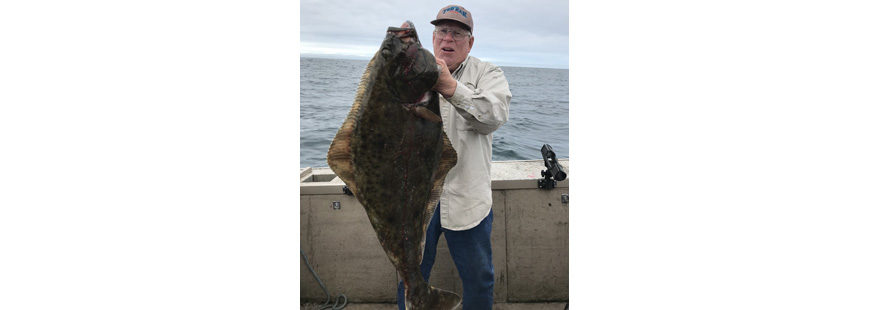Photo: Capt. Bill Kremers with a May 2018 Pacific Halibut from Newport, Oregon
It’s always a mixed bag of emotions when I fly east to Washington DC. I’m headed east to talk about a range of fishery-related issues I work on, on behalf of the Association of Northwest Steelheaders and the Northwest Guides and Anglers Association, and with the National Wildlife Federation.
Flying over the Pacific Northwest offers a different perspective than many get. I see an array of rivers constricted for our power needs, a patchwork of land mass segmented and irrigated for our agricultural needs and maybe a sign of change as a network of giant wind turbines twist in hopes of securing a cleaner future for our citizens and environment.
Just like the wildlife that used to thrive on these terrestrial lands, we get the full monty on how we’ve “managed” this landscape. Nearly one-third of America’s wildlife is at increased risk of extinction, so clearly, we’re failing.
But what about the two-thirds of Earth that we don’t get to see the effects of our past and current policies? Most of the world doesn’t see the plastic bags snagged on the ocean floor, the pilot whale that just died with 17 pounds of plastic in its stomach, the destroyed rocky reef habitat due to poor fishing practices, bleached coral reefs or the depleted stocks of fish that once ruled the oceans. I know… Happy World Oceans Day, right?
We all know change isn’t going to happen overnight, and events such as World Oceans Day are a good place to raise awareness as to polices that have contributed to the decline of the world’s greatest asset, our oceans.
As hopeless as it seems to fix, my wife will tell me, “All we can do is clean up our side of the street.” Although she uses it on a more relational level, it obviously has application to policies and practices associated with our oceans throughout the world.
I’m not a worldly traveler, but I’ll express my biased opinion that I think the United States does a pretty good job managing our fisheries through the Magnuson-Stevens Act, water pollution through the Clean Water Act, and ocean dumping through an array of laws and education on our impacts to the environment. Not all countries have that luxury. It’s not all peaches and cream, however.
Legislation has been introduced that would weaken the conservation mandates outlined in Magnuson-Stevens, which are credited with rebuilding 44 stocks of fish that were severely depleted just 20 years ago. I’m all for utilization of our natural resources to the extent that we don’t compromise the future of the species or our reliance on it, but we’ve already learned our lessons from our past performance, and they were hard lessons to learn from.
HR 200 and the Modern Fish Act are anything but modern. HR 200 especially could over-step proven management that has allowed us access to rebuilt fisheries that have been closed for long periods of time. Why wreck a good track record when we’re headed in the right direction? We know our oceans have future challenges ahead, and we certainly know our impact upon them.
To increase our understanding and knowledge of our impact, we should always look for ways to improve data collection and monitoring in the sportfleet. We have to hold our own community accountable for take, just as we hold the commercial sector in their take. I guess we have it better on the West Coast than some regions; our fresh and saltwater fisheries are closely monitored to ensure we don’t over-do it, so future generations of anglers have the same or better opportunities than we do.
On the west coast, we’re starting to manage down, as salmon stocks begin to feel the full brunt of the drought of 2015, the El Niño event during the same time frame, and the warm water blob that took us all by surprise. Although this year and 2019 appear to be tough ones on salmon returns, it looks like we’ll have an improvement for the future.
The Columbia remains near flood stage for our out-migrating juvenile salmon and steelhead, the warm water blob seems to have dissipated, and the trade winds are whipping up the ocean once again, providing the essential nutrients from off the Continental Shelf for the baby salmon now entering the ocean. Let’s hope the resiliency gene still runs strong in these salmon and steelhead.
No level of global effort can undo all of the damage we’ve left for our children to deal with. Most of us are just trying to quell our future impacts on the ocean; we haven’t gotten to the public conversation on how to reverse our impacts just yet. If there’s one global sentiment that we earthlings collectively subscribe to, it’s that our children are our greatest gift. So the question that should guide all of our management decisions is, “How will they view the legacy we’re leaving behind?” My hope for this World Oceans Day is that their future will be as good as it possibly can be.



It’s really sad how much we have done to damage our aquatic ecosystems. Having traveled a bit myself, I’ve seen the enormous amount of plastic and other pollutants in the Oceans. Truly sad.